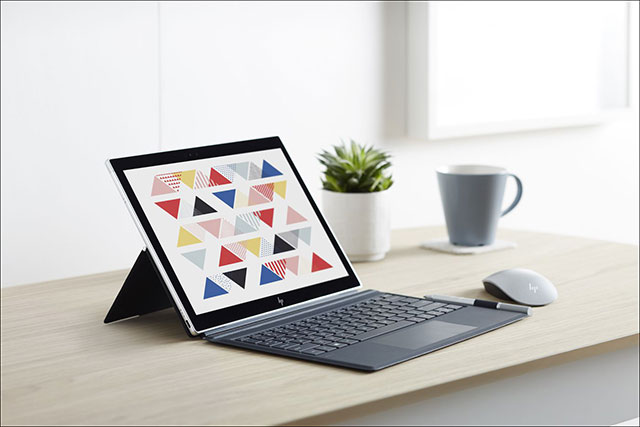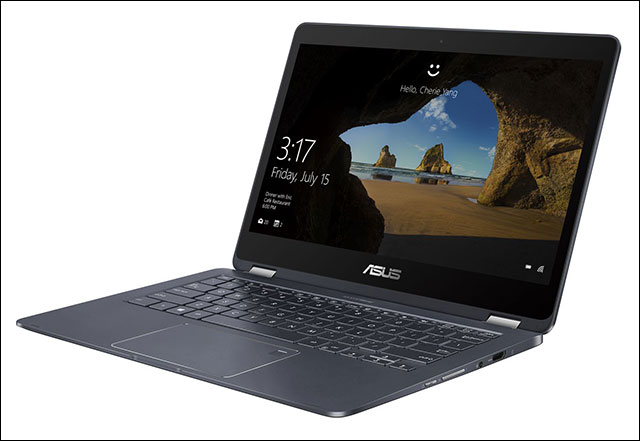Microsoft and Qualcomm introduced Windows 10 running ARM chips all day without running out of batteries
Today, Microsoft and Qualcomm officially revealed Windows 10 laptops running ARM chips. HP, Lenovo and Asus will be the manufacturers of this new laptop, using Qualcomm's Snapdragon 835 processor. Basically, they will look like 2-in-1 laptops / tablets that we still see (using Intel processors), but the main difference is that running Windows 10 and using Qualcomm processors.
Previously, Microsoft introduced Photoshop to run on the ARM version of Windows 10, they also introduced a special simulator to run old x86 applications on these new devices. They look just like regular laptops, running most of the software you still use. HP and Asus have introduced new laptops today, while Lenovo will have to wait a few more weeks.

The HP Envy x2 laptop
The question is why are these devices needed? Microsoft partnered with Qualcomm to create 'always-on' PCs to always connect to LTE and work as if on an iPad, not a regular Windows laptop.
This means that when you turn on your laptop, you can start working immediately, or fold your device without worrying about battery drain. These devices have battery life and LTE connectivity not seen on any Windows-based laptop.
HP and Asis will have Windows 10 S to only run applications from the Windows Store, but people will have to upgrade to Windows 10 Pro for free (at the present time) to install all applications.
See also: If you don't hurry up, you can't upgrade to Windows 10 for free
Microsoft originally let Windows 10 run on ARM chipsets, so all Windows, Edge or shell processes run without emulation. Microsoft also chose the best third-party desktop applications and included in the new DLL system.
Users can download most 32-bit exe files on the network and install on ARM laptops. Except that 64-bit Windows applications are not supported and Microsoft does not support applications that use Kernel Mode. This means that most third-party antivirus software will be incompatible, many games using anti-fraud software will not work either.
Other software such as Photoshop, Office or Chrome run normally. The problem is how they work compared to Intel chip machines when they are supposed to run all day, not to charge regularly. The first machines ran for 20 to 22 hours but in reality could be shorter.
There is also to wait and see if this cooperative product is as expected. Microsoft has also partnered with Nvidia to release a Windows RT tablet five years ago, but battery life was not as introduced, and the OS did not run traditional applications. Microsoft must also learn lessons from this disaster.
See also: Windows RT was officially killed
New laptops will look like normal ones you see, something thinner, lighter, longer battery life and still compatible with good applications.
Asus's NovaGo 2 in 1 has a 13.3-inch HD screen, up to 8GB of RAM and a maximum storage of 256GB. There is also a touch pen, 2 USB 3.1 ports, an HDMI port and a microSD card reader. NovaGo will cost between $ 599 for 4GB of RAM and 64GB of memory. 8GB of RAM and 256GB of memory will be $ 799. HP's Envy x2 is smaller with a 12.3-inch screen, up to 8GB of RAM and 256GB of memory, and also supports a stylus. Both have LTE connectivity.

Asus's NovaGo 2 in 1 laptop
These devices will lay the foundation for the future. We may see tablets and more hybrid devices. If it really works as Microsoft and Qualcomm say, this will be a year worthwhile for Windows laptops. It is rumored that Microsoft is also creating a device like notepad special version running ARM chipset.
See also: Apple considers putting Qualcomm chips on iPhones and iPads next year
You should read it
- Why might a Windows laptop not be a good investment?
- You can now run Windows 11 on a Mac with an M1 chip
- Touch laptop running Windows 8 only 200 USD
- 7 most important things to consider before buying a Windows laptop
- 7 ways to fix Windows laptop errors that do not charge via USB-C
- Fix the problem of unstable WiFi on laptop with Windows 8.1 installed
- Selling price of Windows 7 laptop plummeted
- Here's how to uninstall Windows 10 to return to using Windows 7 or 8.1
May be interested
- Huawei surpassed Qualcomm, becoming China's number one chip supplier
 this is the first time that hisilicon, huawei's semiconductor design unit, surpassed qualcomm in the number of products supplied to the chinese market in the first quarter of this year.
this is the first time that hisilicon, huawei's semiconductor design unit, surpassed qualcomm in the number of products supplied to the chinese market in the first quarter of this year. - Apple 'home' chip manufacturing journey, threatening rulers Qualcomm and Intel
 currently, apple has made a lot of chips for iphone, ipad, mac and watch.
currently, apple has made a lot of chips for iphone, ipad, mac and watch. - Qualcomm shows off the 'superstar' lineup will use the Snapdragon 865
 snapdragon 865 is one of the most powerful 5g chips in the world at the moment.
snapdragon 865 is one of the most powerful 5g chips in the world at the moment. - Detecting Qualcomm CPU errors can cause private data on the phone to leak
 security researchers have revealed a series of dangerous vulnerabilities that allow attackers to steal important personal information of smartphone owners running qualcomm cpus.
security researchers have revealed a series of dangerous vulnerabilities that allow attackers to steal important personal information of smartphone owners running qualcomm cpus. - Qualcomm launches Snapdragon 675, plays games 90% smoother, web surfing speed increases 35%
 qualcomm recently officially introduced the new snapdragon 675 chip with its predecessor upgrades, the snapdragon 670, which could not be obtained as support for 3 cameras, reducing jerks / lag up to 90% when playing games. ...
qualcomm recently officially introduced the new snapdragon 675 chip with its predecessor upgrades, the snapdragon 670, which could not be obtained as support for 3 cameras, reducing jerks / lag up to 90% when playing games. ... - Samsung users have been fed up with the Exynos chip
 the difference in performance between samsung products using snapdragon and exynos equivalent chips has become increasingly common.
the difference in performance between samsung products using snapdragon and exynos equivalent chips has become increasingly common. - Qualcomm introduced a second generation 5G modem speed of 7 Gbps
 qualcomm has just introduced its second-generation 5g modem called snapdragon x55, with some major improvements. this is considered the next generation for 5g modem, snapdragon x50 series.
qualcomm has just introduced its second-generation 5g modem called snapdragon x55, with some major improvements. this is considered the next generation for 5g modem, snapdragon x50 series. - Qualcomm launched the Snapdragon VR development kit
 qualcomm introduced a new vr development toolkit based on the snapdragon 845 platform.
qualcomm introduced a new vr development toolkit based on the snapdragon 845 platform. - Microsoft announced that Windows 11 does not support Apple computers using M1 chips
 thus, users who directly install windows 11 on apple computer models using the m1 chip will not be supported.
thus, users who directly install windows 11 on apple computer models using the m1 chip will not be supported. - Qualcomm has 18 partners ready to use its 5G modem next year
 qualcomm has announced that its snapdragonx50 5g nr product line will be found inside devices manufactured by at least 18 different manufacturers.
qualcomm has announced that its snapdragonx50 5g nr product line will be found inside devices manufactured by at least 18 different manufacturers.










 Officially released HDMI 2.1 standard that supports 10K video and Dynamic HDR
Officially released HDMI 2.1 standard that supports 10K video and Dynamic HDR Google released Android Oreo Go for low-profile smartphones
Google released Android Oreo Go for low-profile smartphones Upcoming Android phones will record 4K HDR video
Upcoming Android phones will record 4K HDR video You can live stream game on Facebook Messenger
You can live stream game on Facebook Messenger Nvidia launched the worst graphics processor ever
Nvidia launched the worst graphics processor ever The latest versions of Windows 10 will bring significant improvements to PC and mobile devices
The latest versions of Windows 10 will bring significant improvements to PC and mobile devices